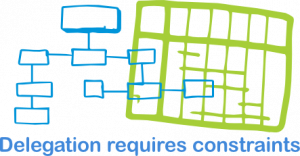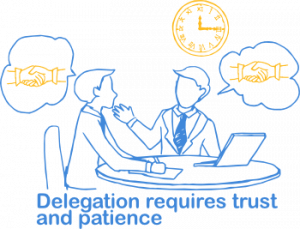Most organizations know that these times of high complexity and fast-paced change are a challenge to cope with, especially for management. It’s not that traditional management techniques are wrong per se, but they are no longer the most appropriate way to face today’s complexity. So organizations are struggling to implement alternative ways of managing: Employee empowerment; servant leadership; decentralized decision making; delegation; self-organizing teams, these are all terms for the same concept: put the authority where the information is. The concept proofs to be pretty hard to implement, however. This article will demystify empowerment and delegation and provide some simple yet powerful tools you can use today.
This article is part of a series
[series_post_list_box]
What can you expect from this two-part article?
- Understand why empowerment is important
- The principles behind successful empowerment
- Simple yet powerful tools to start implementing empowerment in your organization
WHY IS EMPOWERMENT IMPORTANT?
The reason empowerment is important is that it enables faster and better decision making. Today’s organizations operate in a complex environment. You cannot rely on following proven optimized processes and best practices because the work is not that predictable anymore. We often find ourselves doing things we haven’t done before. We need experts that can analyze complicated situations, and creative workers that know how to quickly create and validate ideas using experiments. These workers most often know the work better than their managers. So let them decide: decisions will be better because they know better. And they will be faster because the hierarchal chain of authority is short-circuited.
In many organizations, managers get hired or promoted based on their knowledge and expertise. But as complexity grows, it is impossible for a manager to keep up and know everything. A manager can easily become a bottleneck in decision making this way.
CREATE THE RIGHT ENVIRONMENT FOR EMPOWERMENT
Before we get to the actual principles of empowerment itself we must cover the pre-conditions of empowerment. Remember that empowering actually means we are going to re-distribute authority. We are going to rely less on the existing hierarchy to control decision-making. This means we need to replace it with something else.
ENGAGEMENT
An engaged workforce is an important precondition for empowerment. Engaged employees align their own personal goals and values with those of the company. This means they are very motivated to pursue the goals of the company because these are actually their own goals. It is not hard to imagine that we can let engaged employees make more decisions on their own.

READ MORE ON ENGAGEMENT
For more information on engagement have a look at our series The Truth about Employee Engagement..
PURPOSE & VALUES
For engagement to work it must be clear to everybody why the organization exists and how someone can contribute. This is the job of a Purpose. A purpose acts like a north star. It guides everybody in long-term decisions.

If the purpose helps us make long-term decisions, core values help in daily decision-making. They serve as a checklist that employees can use to judge whether a decision they are about to make is desired or not.
It is not easy to define good values. Don’t settle for motherhood and apple pie like values that everybody uses like integrity, quality, or customer service. Those will not set you apart from anybody else. And besides, would anyone every embrace values like ‘poor quality’ or ‘poor customer service’?. Here are some suggestions:
Values cannot be compromised. Don’t set a value unless you are really prepared to uphold it.
Express values in terms of the behavior that exemplify living by the value.
Rank values to prevent exchanging one dominant value for another. For example, as an airline company you will probably have a value about safety. This is the most important value because you do not want somebody to exchange safety for another value and get away with it.
Exploring principles of empowerment
A tale of Sam
So let’s assume we have an old school command-and-control type of manager, called Sam. Don’t blame Sam by the way, because it’s organizations and the education system that create and maintain Sams. Sam takes part in a new management program in his company with the purpose of turning managers into servant leaders. Sam gets the reason why. He is enthusiastic about the change, a little anxious perhaps, but his guts tell him this is a more effective way. So he is going for it.

A few weeks go by and Sam is feeling increasingly frustrated. Things are not changing as fast as he had expected. He feels people could be more proactive. Why aren’t they taking initiative?! After all, he has given them every room to do so. Why do they not seem to feel accountable for results? He has just told them what results he expects leaving the ‘how’ up to them, just as they taught him in the servant leadership workshop he attended. But it hasn’t led to better results yet. As a matter of fact, he was forced to step in a couple of times to correct mistakes that were made. He feels that at least some team members cannot handle responsibility. Or maybe they just prefer to be controlled.
This is not an uncommon scenario. Agile coaches and Servant Leadership aficionados will tell you people want to have control over their own work. So why does it proof to be so cumbersome and slow to implement empowerment and delegation? Let’s unravel the principles of empowerment and delegation.
Delegation requires constraints

Although it might sound contradicting, if you set clear boundaries and are very transparent on them, you create a safe environment for taking initiative.
Delegation is reflexive

An honest conversation between employees and manager is needed to find out what level of delegation everybody feels comfortable with at the moment for every decision area. Find out what is needed to further delegate a decision and work towards that.
Delegation requires trust and patience

Empowerment is an investment, it may take a while before you get your return on investment. Remember, people are wired for compliance. Not by nature, but by organizations and the education system. It starts as soon as children go to school: Suddenly you are required, both literally and figuratively speaking to color within the lines. Mistakes are structurally corrected. “Making a mistake is wrong” is the unconscious message. All day you are supposed to do what you are told. It gets even clearer when you start your first job. Others tell you what to do and how. All employee engagement programs set aside, people feel they are expected to comply. So when you are genuinely trying to change this in your organization, know it will take a while for people to change.
Give and ask intent, rather then give instructions and get compliance

It works the other way around too. By asking for somebody’s intent a manager has an opportunity to express his opinion without taking away the psuchological ownership of the decision.
Conclusion
Empowerment is important to improve the speed and quality of decisions. It is also hard to implement. First you need to understand that removing part of the chain of command needs something to replace it with: engagement, purpose, and values. And if you then get to the actual delegating there as some important principles to watch out for.
Understanding these principles is one thing, using them is another. In part 2 of this blog we provide effective tools for delegation that honours the principles just discussed.
Follow this article
You can choose to follow this article in which case you will be notified when there there are updates of the article. You can also choose to follow all articles of this category. You will then be notified if a new article is added in this category.




